
There's a great divide between business and IT in the traditional software development world. As a result, we have a communication gap, an IT backlog that keeps increasing, and more prominent companies losing market share to innovative upstarts.
"The current software development paradigm is based on the divide between business and IT. Business users explain the requirements to developers who then translate these requirements into code, often resulting in communication degradation", said Jesse Shiah, Co-founder, and CEO of AgilePoint.
He argues that the traditional divide between business and IT makes application development costly and challenging to maintain. Plenty of time passes from when IT captures user requirements to when it translates these requirements into code, which also increases the technical debt.
The picture below captures the essence of this business-IT divide.
Fig-1 The Great Divide between Business and IT
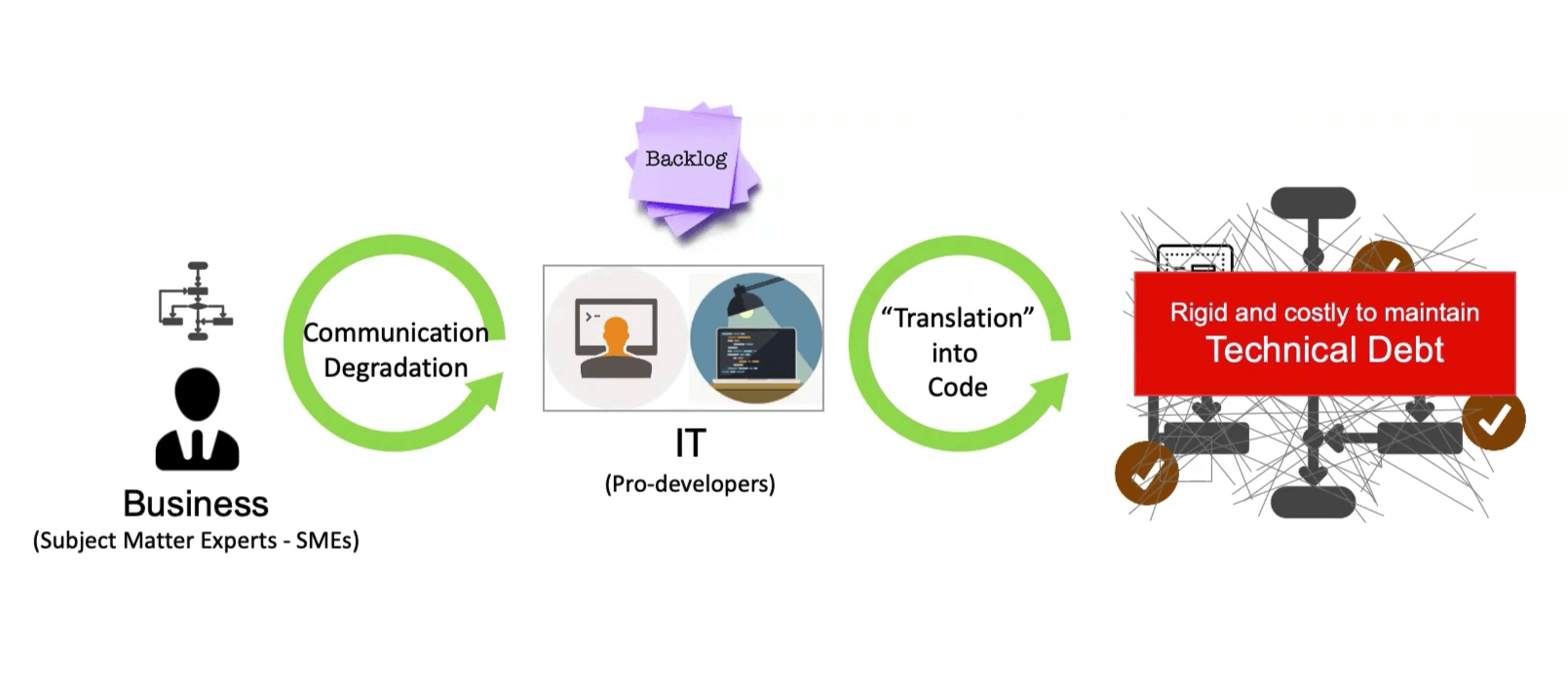
In an event organized by the Project Management Institute in March this year, Jesse delivered a talk, "Citizen Development The Missing Link to Sustained Digital Transformation." Jesse explored the challenge of the business-IT divide and cited Citizen Development as an effective solution to bring business and IT closer together. Here are the highlights from his presentation at the
PMXPO 2022 - PMI Virtual Experience Series.
Digitalization vs. Digital Transformation
To illustrate the distinction between Digitalization and Digital Transformation and the drawback of using Agile methodology to overcome the substantial business-IT divide, Jesse showed the audience a slide that captured the essence of the differentiation between Digitalization vs. Digital Transformation. Many companies confuse Digitalization for Digital Transformation and assume that Agile methodology is the answer to increasing business and IT collaboration and thereby achieving rapid transformation.
Fig 2- Digitalization vs. Digital Transformation
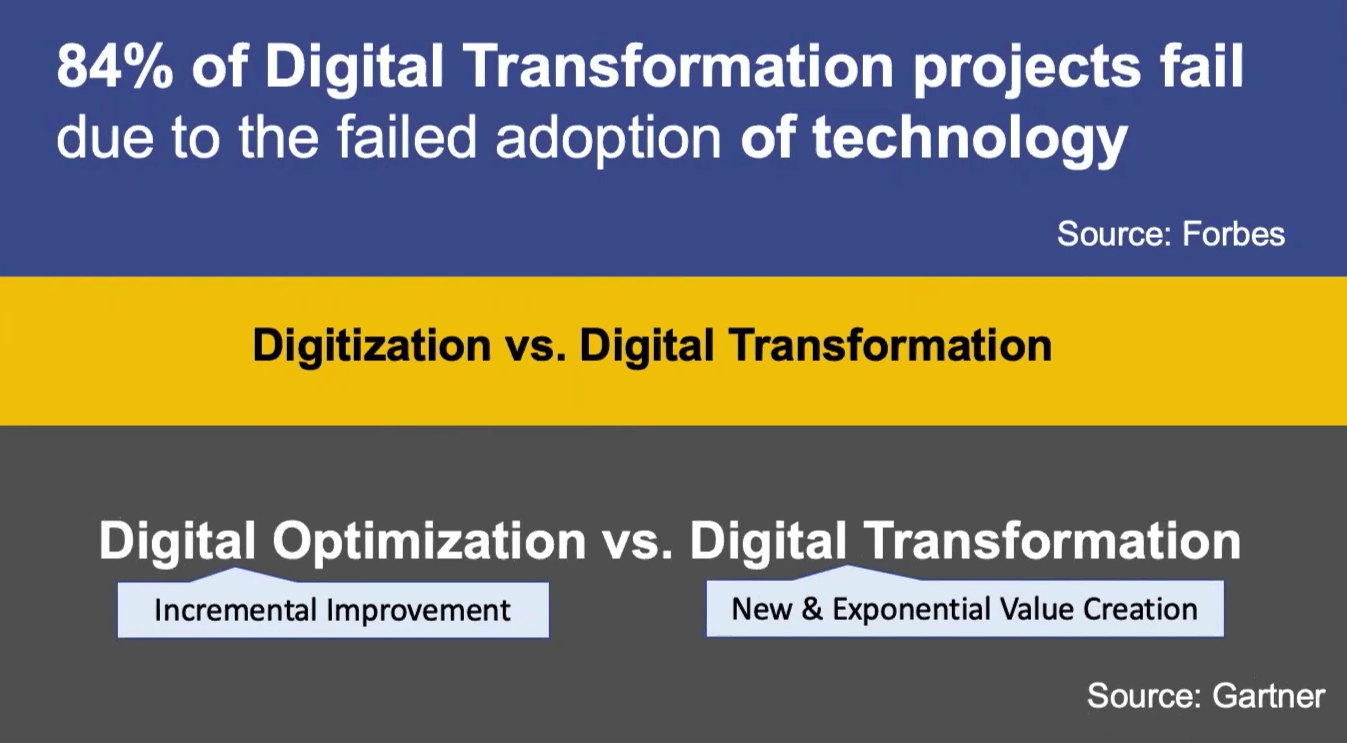
"Someone may say, wait, I thought we practiced agile methodology. Doesn't that help solve this problem? The answer is no, as the agile methodology doesn't change the paradigm, and it only enables us to deal with this challenge in a faster cycle", said Jesse.
Jesse argued that a sustainable Citizen Development program or a Citizen Development Center of Excellence (CoE) is the missing link to overcome the tremendous business-IT divide and achieve new and exponential value creation.
Jesse outlined three critical characteristics that executives can use as markers of an enterprise-ready and sustainable Citizen Development platform. He also outlined the low-hanging fruits of a Citizen Development program.
The talk revolved around:
- Three must-have characteristics to look for in Low-Code/No-Code tools to ensure the sustainability of Citizen Development programs.
- What are the low-hanging fruits that we can very quickly create exponential value to accelerate Digital transformation?
Three Must Have Characteristics of an Enterprise-ready Low-Code/No-Code Development Platform
Low-Code and No-Code Platforms should not be separate
Companies that chose Low-Code and No-Code tools separately where both platforms have a different architecture soon run into IT governance challenges.
"We believe that the Low-Code No-Code tools should not be separate, and they need to be built based on the same architecture," said Jesse. "Both Low-Code and No-Code should be based on the same platform to enable anything being created at a No-Code layer to have strong governance. We're talking about a strategic platform for both IT and Citizen Developers. So if we take that into a more detailed view at the No-code layer, we want to provide comprehensive capabilities".
"For example, hundreds of automation activities could supplement past automation, workflow automation, or integrations. So, you can model your process very quickly. You'd be able to design your forms and mobile apps, have data modeling, look up multiple different systems, integrate applications and systems through visual drag and drop features, and create a digital experience through web-based portals and mobile apps".
Jesse shared the key capabilities that your No-Code tools ought to have.
Fig 3- Key Capabilities of an Enterprise No-Code Tool

This No-Code layer should not be standalone and must be supported with an extensible Low-Code layer. “A layered architecture must enable the professional developers to create additional custom Low-Code activities to extend the platform,” said Jesse. He cites it as a critical capability for Citizen Development to be sustainable in the enterprise.
Fig 4- Layered Low-Code No-Code Architecture
New Paragraph
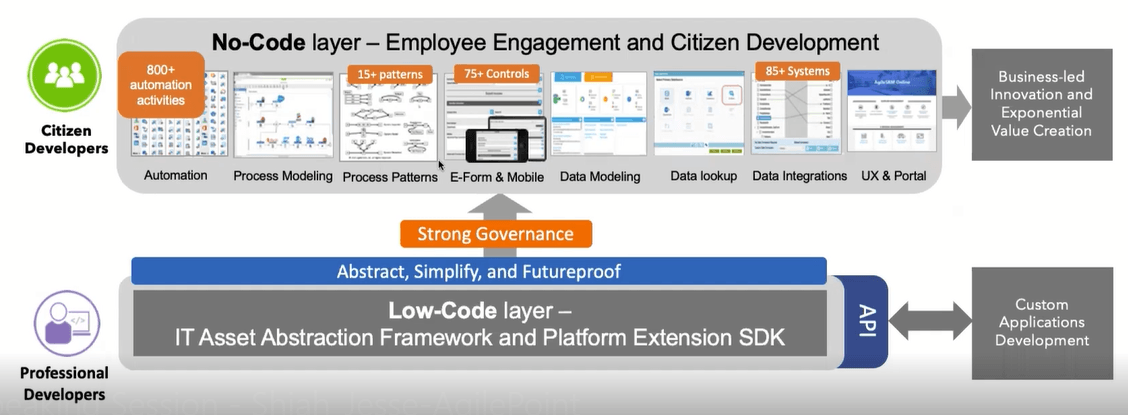
Model-driven Low-Code No-Code instead of Code Generation
If your Low-Code No-Code software generates code instead of an executable model, your application infrastructure will soon accumulate technical debt.
“Also known as code debt, technical debt describes what results when development teams take actions to expedite the delivery of a piece of functionality or a project which later needs to be refactored.”
Jesse recommended looking for a Low-Code tool that generates an application model instead of code to keep your Citizen Development program sustainable.
“Unlike many tools that leverage code generation to create applications, we must look for Low-Code solutions based on an abstraction framework and model-driven architecture,” said Jesse. "In this case, it preserves the application or process as a model from design to execution. When you want to come back to improve, you will still be working on the model. It is the only way to scale Citizen Development in an organization, especially in a large enterprise”.
It empowers Citizen Developers to create applications that are still sustainable to govern for IT. Jesse cites the example of how AgilePoint can develop apps as a model.
Fig 5- Model Driven Execution
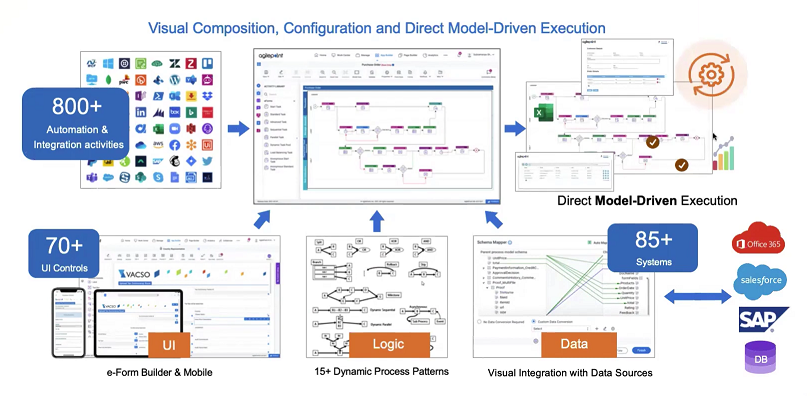
"So when we create an application, typically we involve the UI presentation, logic, and data. So all three key components can be drag and drop and configurable as in the model-based environment, including all automation integration activities. This model can then directly drive execution. So this can never turn into difficult to maintain codebase".
Low-Code No-Code Platform Supports a Wide Range of Use Cases
In enterprise use cases, task-specific no-code tools increase the IT's burden to maintain and govern these 3rd party tools effectively. Jesse argues against having task-specific Low-Code No-Code (LCNC) tools as it undermines large companies' security, governance, and compliance posture.
"The Low-Code solution we select must not be task- or use-case specific; it has to support a wide range of use cases to avoid application sprawl. We don't want specific Low-Code for spreadsheet, another for mobile, another for database, and yet another for forms, " said Jesse.
Jesse recommends a platform that can handle both task and process automation without switching the tool.
Fig 6- Spectrum of Use cases for Enterprise Low-Code No-Code Platform
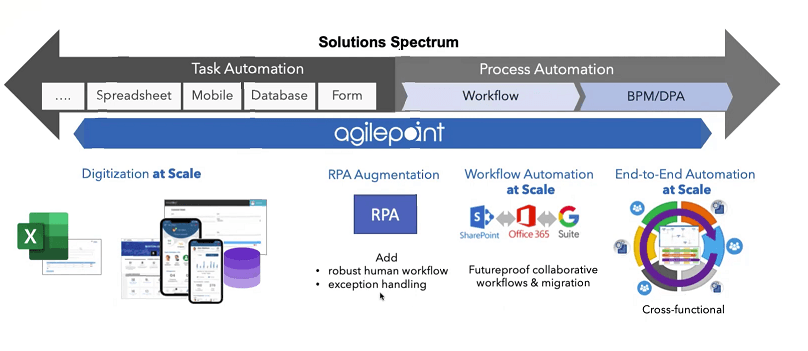
“We want one platform that supports all these use cases across all the processes within use cases for task and process automation. It would enable the organization to be able to pursue digitization at scale. It is where a lot of Citizen Developers will be the best place to get started,” Jesse mentions the importance of having a unified Low-Code No-Code infrastructure.
He further explains the platform capabilities and underlying infrastructure capable of building cross-functional and cross-purpose use cases.
“In between, you can create collaborative automation, the workflows, and at the same time, use Robotic Process Automation (RPA) to supplement your automation to deliver more robust human workflows and exception handling.”
“Another important aspect of your LCNC platform is that it should ensure and support the future growth of your applications. So an application being created can be deployed on-prem or in the cloud, or maybe for one cloud, the other cloud without having to go back and refactor”.
Fig 7- Application Types - Layered Low Code No Code Platform
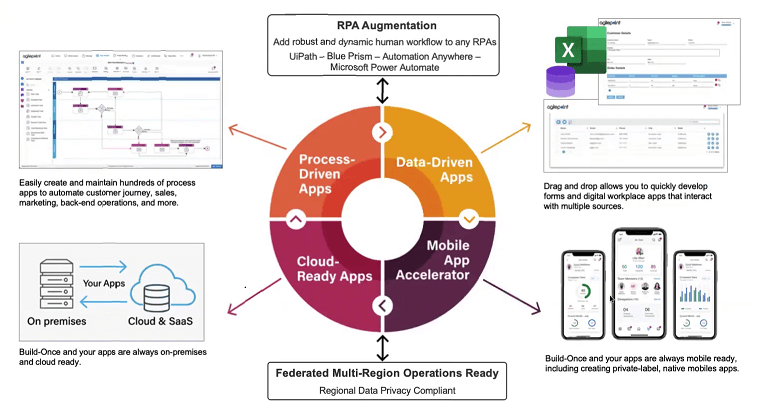
Low-Hanging Fruit for Creating Exponential Value through Enterprise Citizen Development
Every company tries to get a leg up on its competition. However, how it gains a competitive advantage varies.
Gartner and Forrester have extensively published research on how organizations may approach automation. The image below has some details of it.
Fig 8- Gartner & Forrester on Automation at Scale
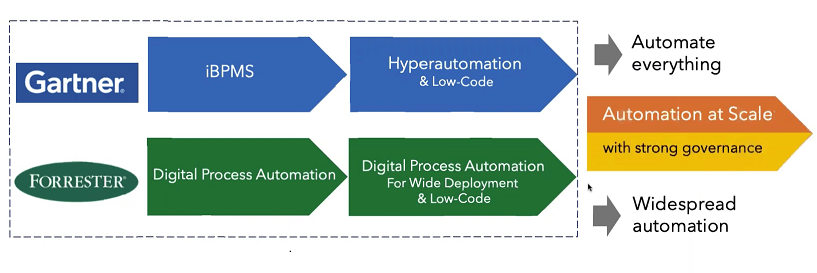
Cross Functional Automation
To scale your automation initiatives, you must think strategically beyond individual departments. It might start with one use case or functional area, but the platform should empower teams to scale solutions across the group, subsidiaries, and business units. That’s what Mckinsey calls “cross-functional automation at scale.”
“McKinsey has published research and mentions that to achieve digital transformation, one must simultaneously be able to implement an agile operating model by creating cross-functional automation and transformation at scale. So this means we need to be able to enable agile collaboration from multiple different functional areas”.
Agile Operating Model
Many low-code tools are all specific to one task or use case, leading to incremental improvements in particular areas. What does achieving the agile operating model with cross-functional automation at scale?
"The key here is to be able to very quickly create cross-functional automation at scale, what McKinsey identifies as the key to achieve digital transformation."
To achieve cross-functional automation at scale, let's look at the most broken processes and how sustainable Citizen Development embeds the subject matter experts (SMEs) at the center of transformation programs.
"There are no better people to help achieve Digital Transformation than the subject matter experts (SMEs) who become Citizen Developers because they know the business and not just the business dynamics; they are the best people to implement that cross-functional automation at scale," said Jesse.
Fig 9- Cross Functional Process Automation
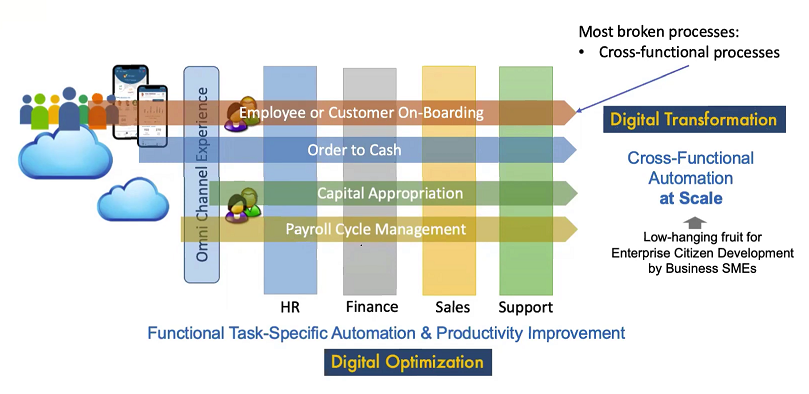
Application Rationalization through Enterprise Citizen Development
Below we list a few case studies of organizations that have already practiced and created exponential value by incorporating the Citizen Development approach.
"A Fortune 100 company created 8,000+legacy automation applications in 15 years, many of those for SharePoint. When the customer decided to move to Office 365, it felt challenged to rebuild all these automation apps".
That's when the said company started reducing the number of applications and ensuring that these apps would be future-proof. To eliminate challenges associated with migration and refactoring apps, they used AgilePoint and created about 2000 of these future-proof automation applications in nearly two years.
"These 2000+ automation apps are spread across 100s of different use cases because those use cases run the global operations supporting thousands of users. Thus, the well-governed Citizen Development program proved scalable and sustainable".
Extreme ROI
"The customer was able to consolidate technology footprint, and multiple platforms became one. Secondly, the customer rationalized their application portfolio from 8,000 to 2000 apps. The company's transformation initiative exceeded 30% or 50% savings".
Activating Citizen Developer and Advancing Careers
Another recurring promise of the Citizen Development paradigm is that it puts 'Citizens' in the driving seat of contributing toward their employer's automation initiatives and advancing their careers.
"Gary came one day to AgilePoint's website, asking for a trial, and mentioned that he worked at a Fortune 100 for more than 15 years in procurement. He was laid off during the pandemic but couldn't find another procurement job until he put his AgilePoint experience on his resume. He was hired the second day as he had learned AgilePoint and created about 20 procurement-related automation based on AgilePoint".
A Fortune 100 Company Uses Citizen Development across Global Subsidiaries
Another global company used Citizen Development to grow the company by acquiring subsidiaries globally.
The company adopted enterprise Citizen Development to very quickly create cross-functional automation, but at the same time achieved the typical bottom-line benefits such as cutting down the cost, cutting down the cycle time, and taking it to the next level.
Cross-functional and Cross-entity:
Not only does the company develop cross-functional but also cross-entity automation. Even with many subsidiaries, the customer could collectively digitalize processes with more than 5 million processes running every year across headquarter and subsidiaries. It helped the company to increase organizational resilience and agility. Instead of each subsidiary building its version of processes, for example, a PO process, it created one PO process solution and dynamically mass-individualized and adapted for different subsidiaries.
Take things to the next level by requesting your FREE AgilePoint trial today.
Are you ready to reengineer your business
automation processes?

A modern process automation and orchestration platform that enables you to open up and seize new business opportunities, supercharge innovation, unlock new levels of efficiency and productivity, and deliver the experiences that help you win.
Follow Us
Platform

Automate business processes and workflows at scale. AgilePoint helps enterprises democratize and accelerate digital transformation, reduce technical debt and future-proof ROI.
Resources
© 2023 AgilePoint. All rights reserved.



